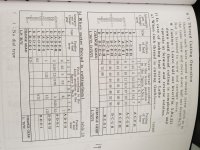I'm wondering if anyone can decipher my lathe (Whacheon HL-460) with regards to cutting metric threads.
Sorry if these pics do not show up rotated the right way.
First, I do have the manual. But, I notice the manual identifies various levers in the wrong position. So that kinda adds to the confusion.
I want to cut 1.0 metric threads...1 thread per mm.
So....how do I read these charts? My lathe is presently set up with the 36/72 gear set.



Sorry if these pics do not show up rotated the right way.
First, I do have the manual. But, I notice the manual identifies various levers in the wrong position. So that kinda adds to the confusion.
I want to cut 1.0 metric threads...1 thread per mm.
So....how do I read these charts? My lathe is presently set up with the 36/72 gear set.









